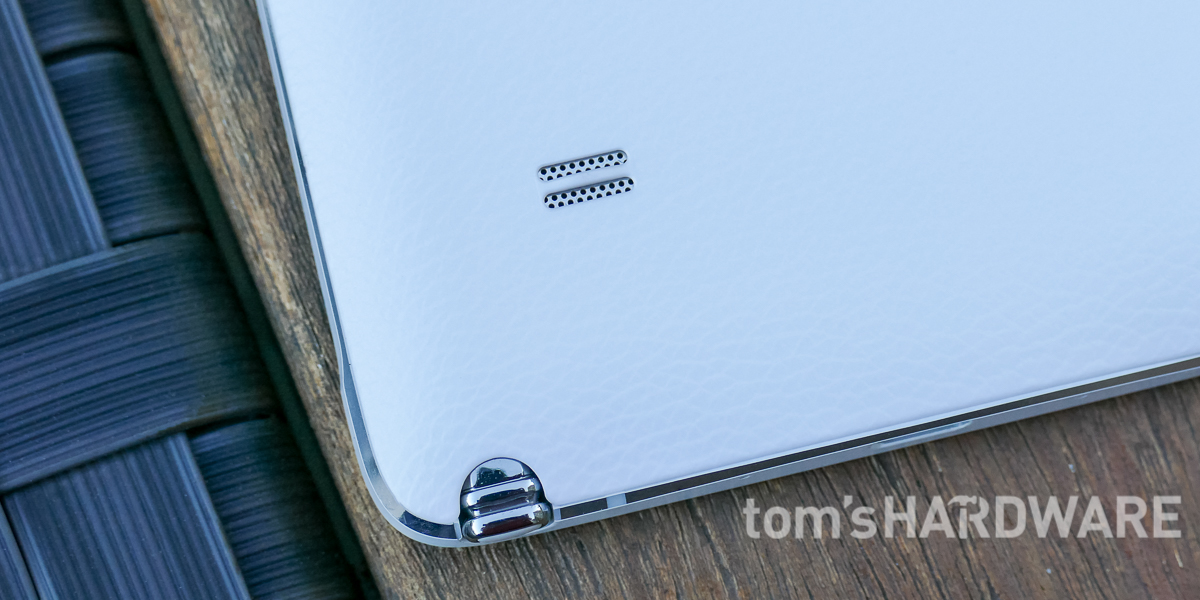Samsung Galaxy Note 4 Review
The Samsung Galaxy Note 4 sports a big, high-quality screen; large, removable battery; speedy processor; stylus; and specialized software for power users.
Why you can trust Tom's Hardware
Display And Audio Performance
With each generation, Samsung improves its SAMOLED display technology, achieving higher brightness levels and more accurate colors. The Galaxy Note 4 is no exception. In addition to these improvements, screen resolution has been increased from HD to QHD for the Note 4, which helps compensate for the PenTile pixel layout having fewer red and blue subpixels as compared to an RGB stripe LCD display. Even after accounting for the discrepancy in subpixels, the Note 4 has a higher pixel density than a 1080p LCD.
In an effort to improve our mobile reviews, we are now using SpectraCal's CalMAN software and SpectraCal C6 colorimeter for display measurements. All of the charts below with a gray background were generated in CalMAN v5 Ultimate.
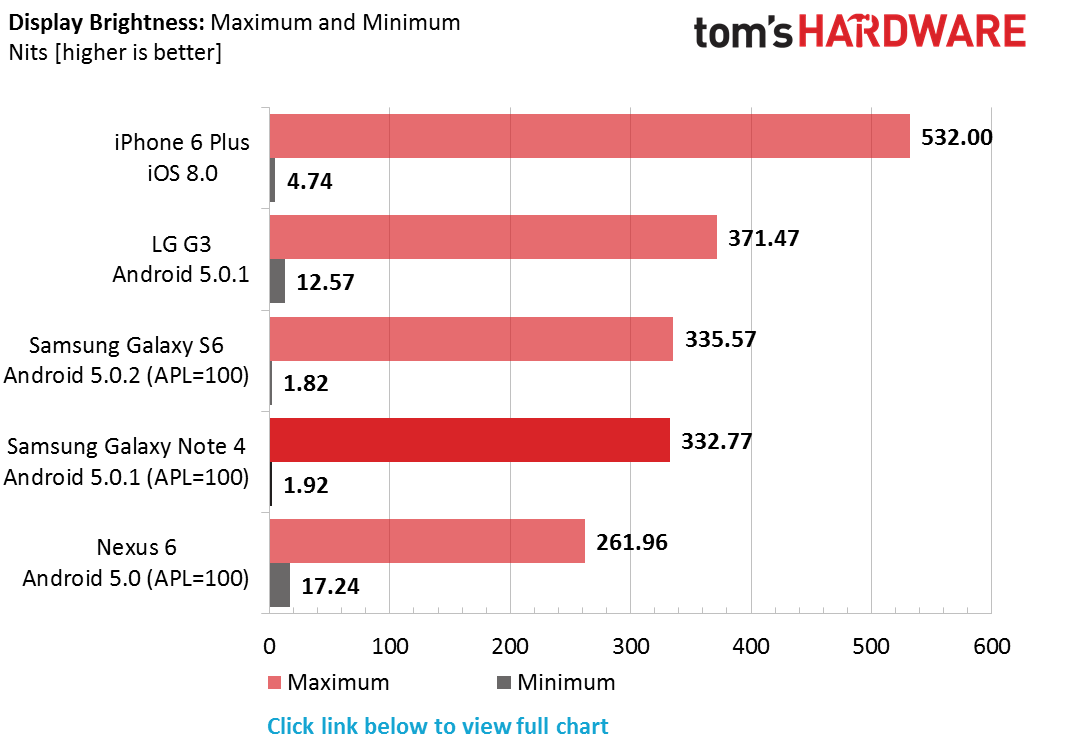
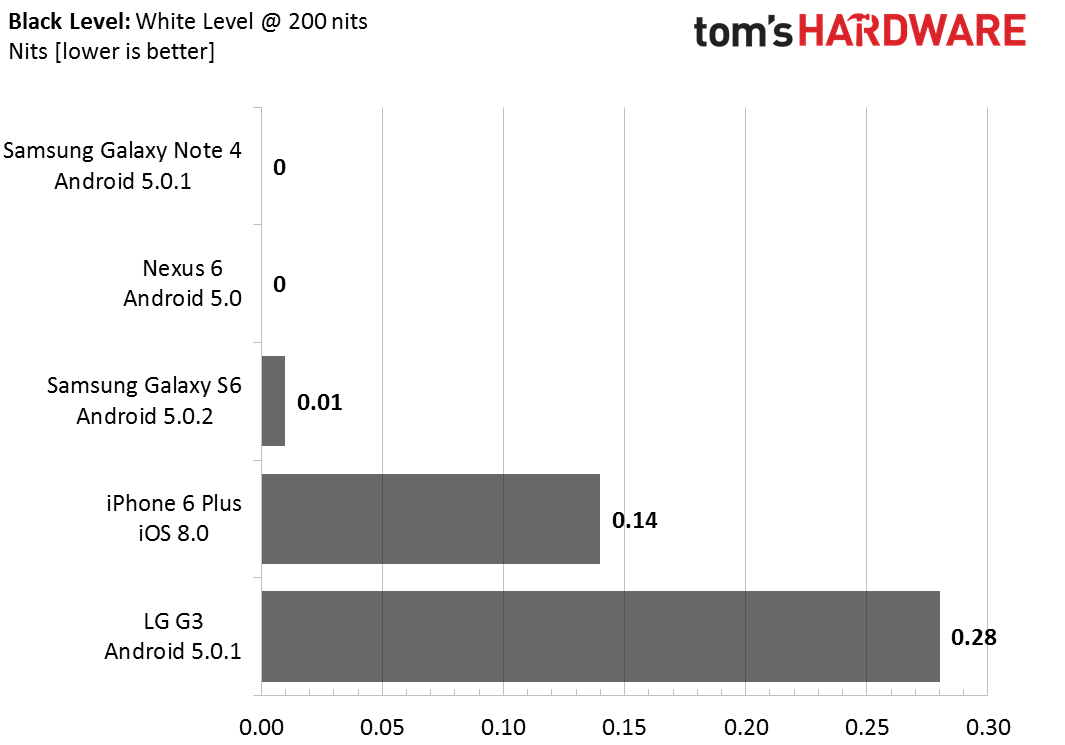

Full Brightness chart including values for APL=50 and auto-boost.
We are now reporting two different brightness levels for AMOLED displays: APL=50% and APL=100% (APL stands for Average Picture Level). If you are unfamiliar with APL, here is a good article explaining what it means. Basically, the brightness of an AMOLED display changes depending on what content is actually being displayed. The APL values we chose to measure provide a good upper and lower bound for what's practically achievable.
At an APL of 100%, which serves as a worst case condition, the Note 4 manages to exceed 300 nits, matching the brightness of the display in the newer Galaxy S6. This is also significantly higher than the AMOLED display in the Nexus 6, although it's still less than what LCDs can achieve. Looking at the full brightness chart shows only a modest brightness increase for an APL of 50%, again tying the display in the GS6 but a little shy of the Nexus 6. With a max brightness between 333 to 363 nits, the Note 4 is sufficiently bright for any indoor scenario, but not bright enough for outdoor viewing in sunlight.
Fortunately, Samsung provides a little trick for just this situation. If the Auto brightness mode is activated and the ambient light exceeds a certain threshold, the display brightness gets a significant boost. In this "boost" mode, max brightness shoots up to between 500 and 630 nits, equaling or even exceeding the best LCD displays. While no OEM will ever be able to make a display that can compete with the sun's brightness, this at least makes the screen visible. Of course a boosted display uses more power, and it can only maintain this brightness level for a short period of time before the screen overheats and the brightness falls back to normal levels.

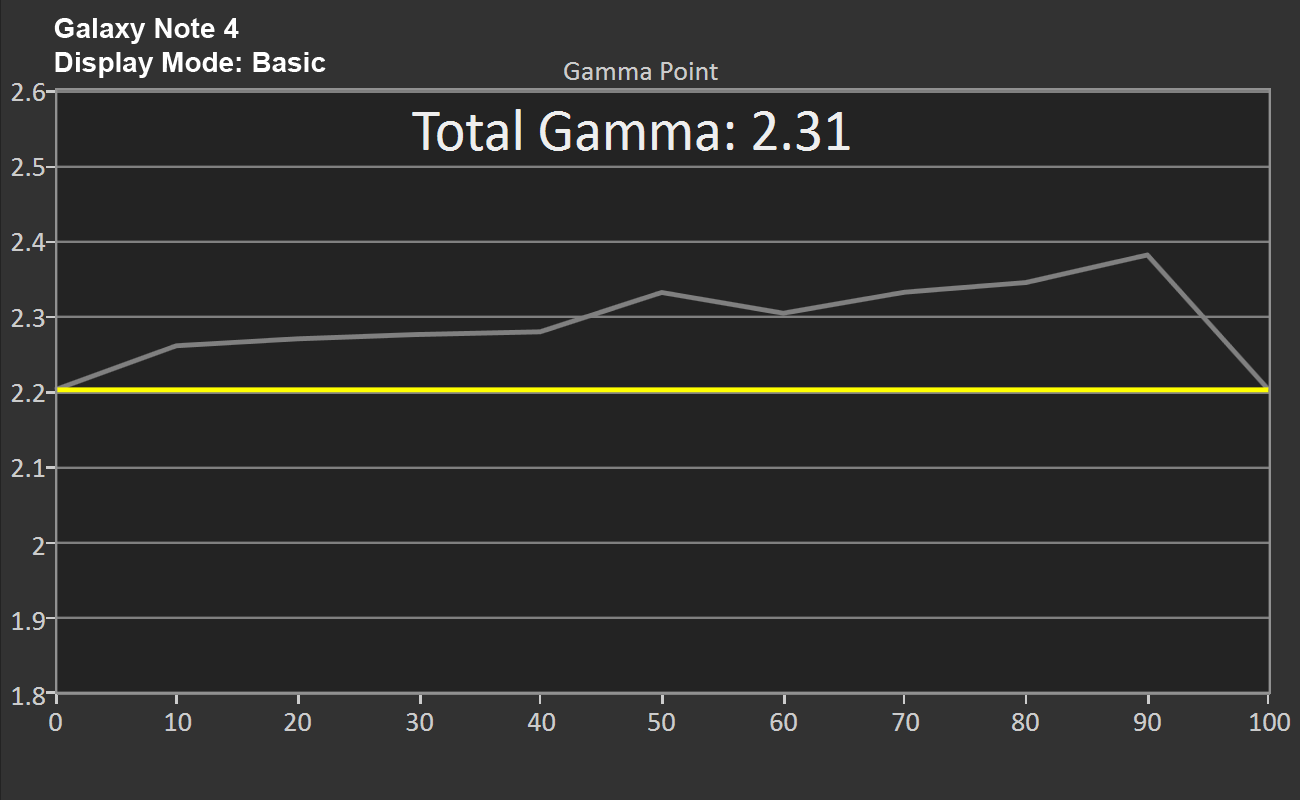

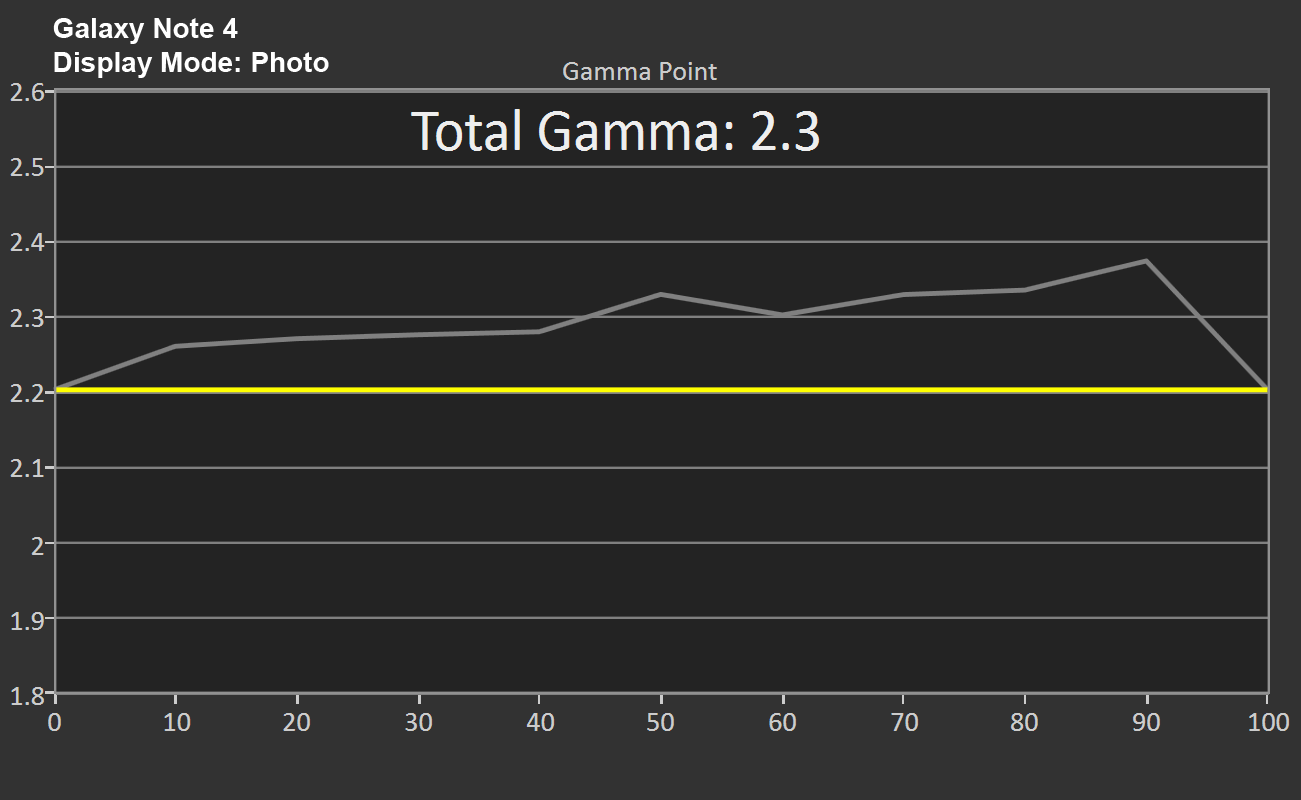
The Galaxy Note 4 has four different screen modes with different gamma curves, color gamuts, and color saturation levels: Basic, Cinema, Photo, and Adaptive display, which automatically adjusts—or "optimizes", according to Samsung—these screen parameters based on the app that's being used. This mode is rather limited, however, only affecting six specific apps, making it difficult to test. Instead, we'll focus on the other three modes. For testing purposes, the "Auto adjust screen tone" setting, which automatically adjusts the screen luminance based on the content being displayed, is turned off.
Get Tom's Hardware's best news and in-depth reviews, straight to your inbox.
The average gamma for the Note 4's Cinema mode comes the closest to the ideal value of 2.2; however, its gamma curve tells a different story. Below a grayscale level of about 55%, gamma spikes to 2.56 leading to darker shadows and a loss of highlights. Above 55%, gamma drops to a minimum of 1.34 resulting in a significant loss of shadow detail.
In contrast, gamma remains very consistent across a full grayscale sweep in both the Basic and Photo modes, coming in just above the ideal value.
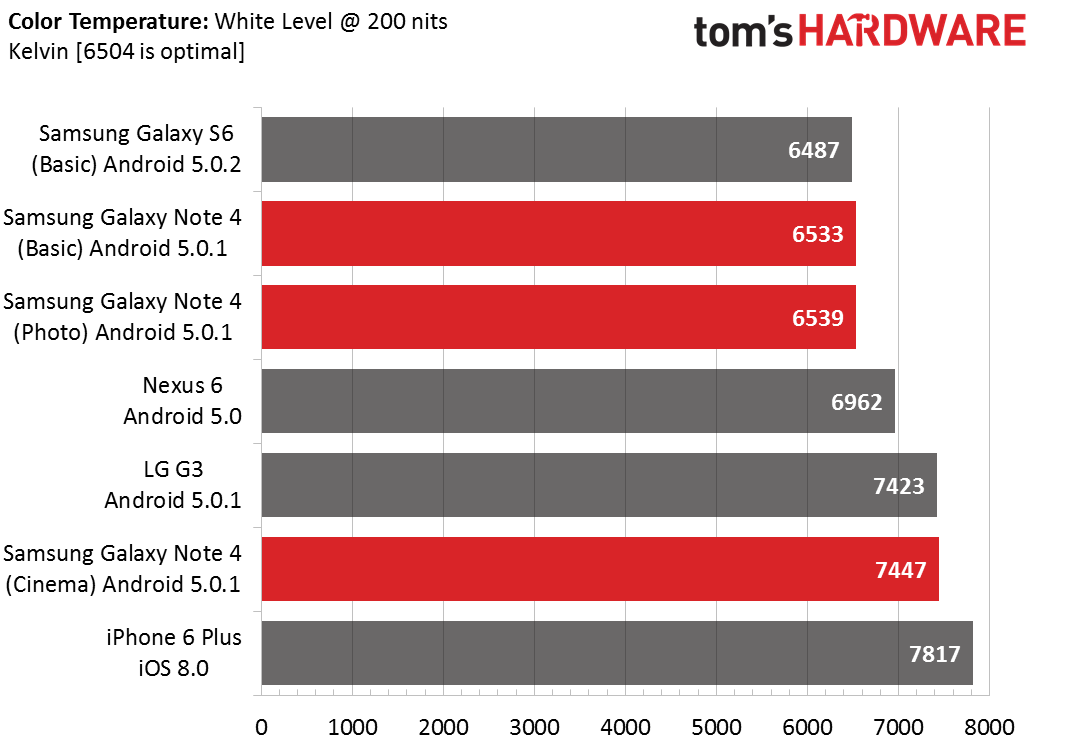


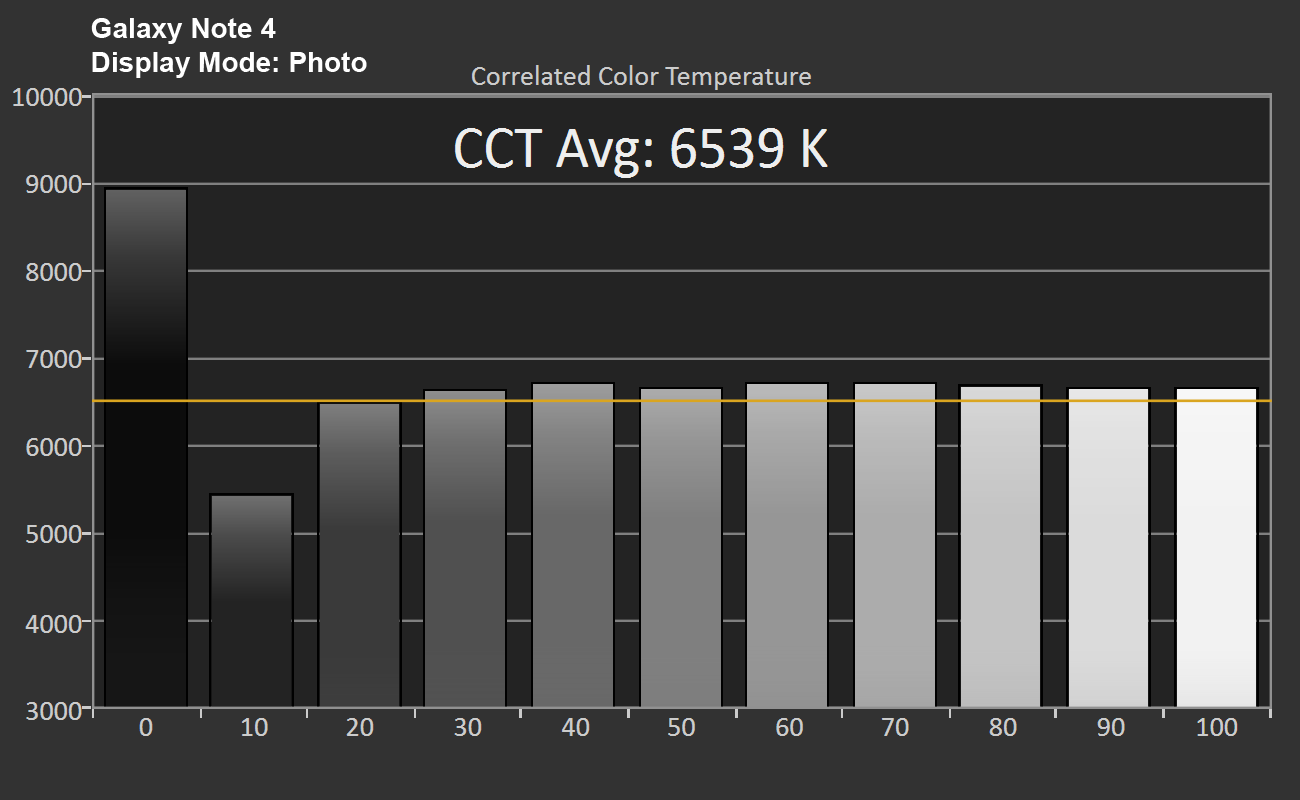
Color temperature is spot on in both the Basic and Photo modes, with essentially no variation across a full grayscale sweep (values close to 0% are not accurate). Cinema mode eschews absolute accuracy and instead opts for a cooler color temperature similar to what we see in most mobile displays.
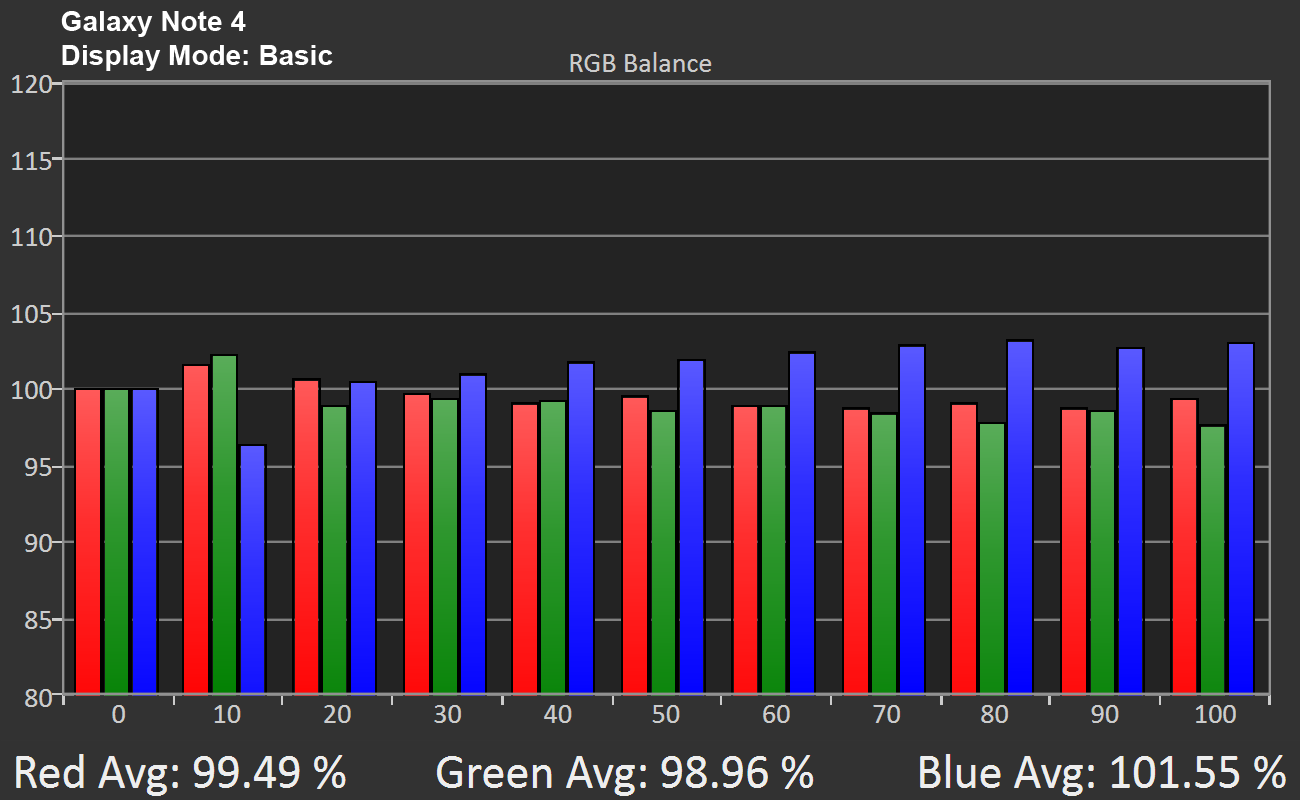

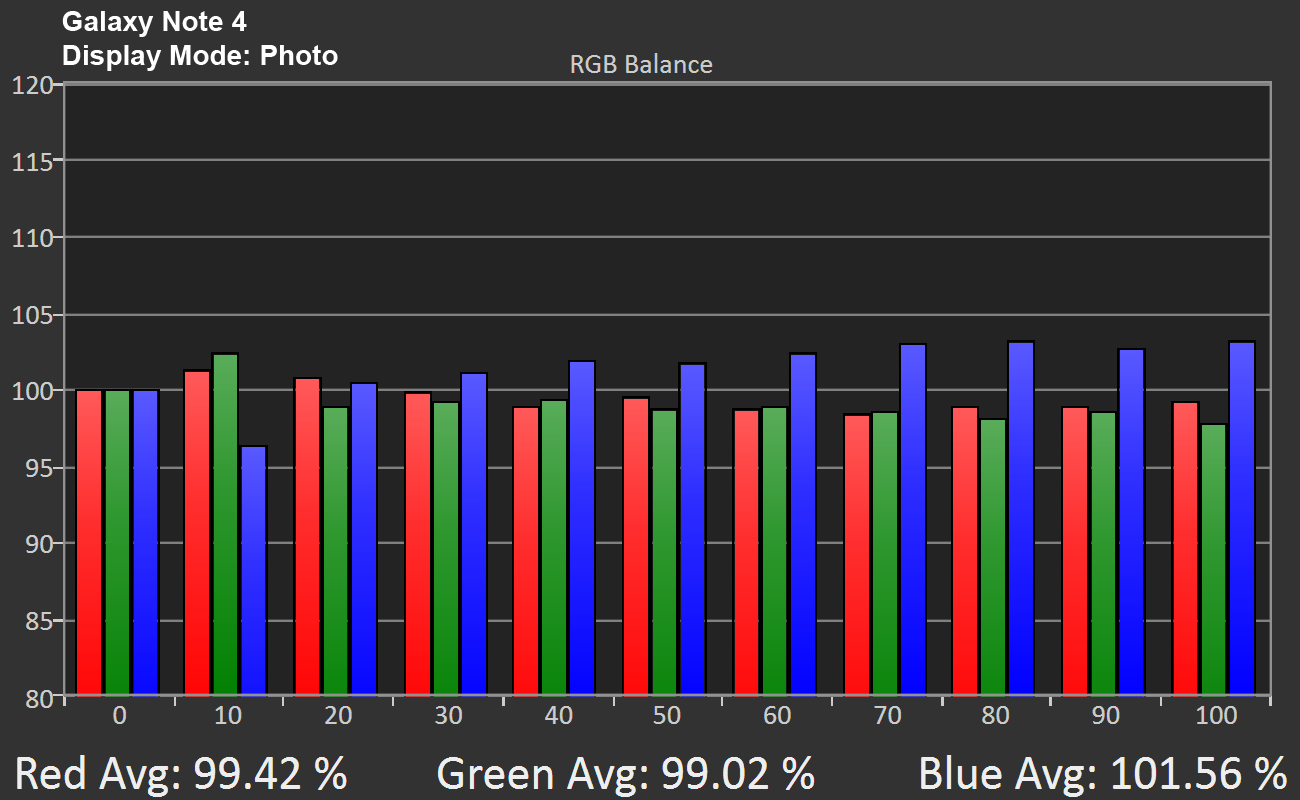
Looking at the RGB balance we can see why the Basic and Photo modes land so close to the ideal color temperature: no single primary color varies by more than ±4% for any grayscale level. Cinema mode on the other hand clearly emphasizes blue over red, leading to its cooler color temperature.

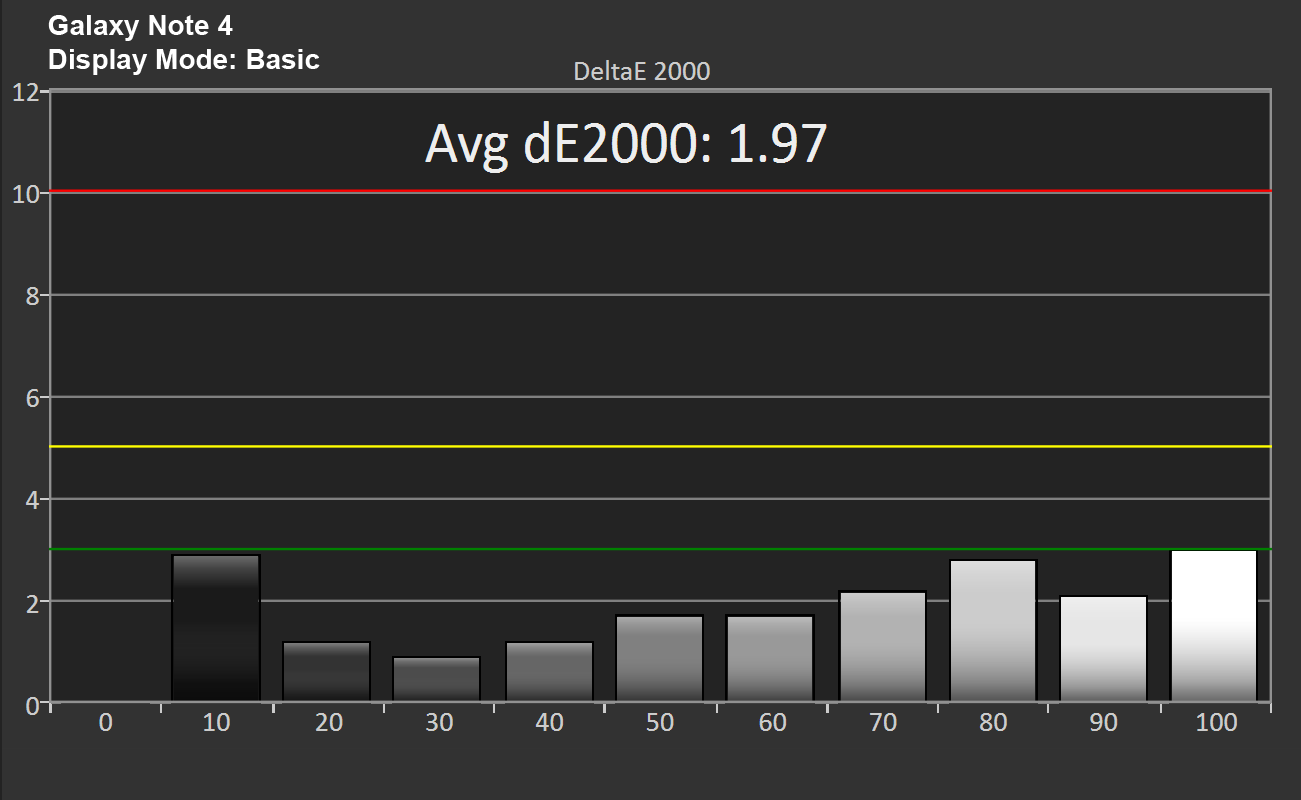

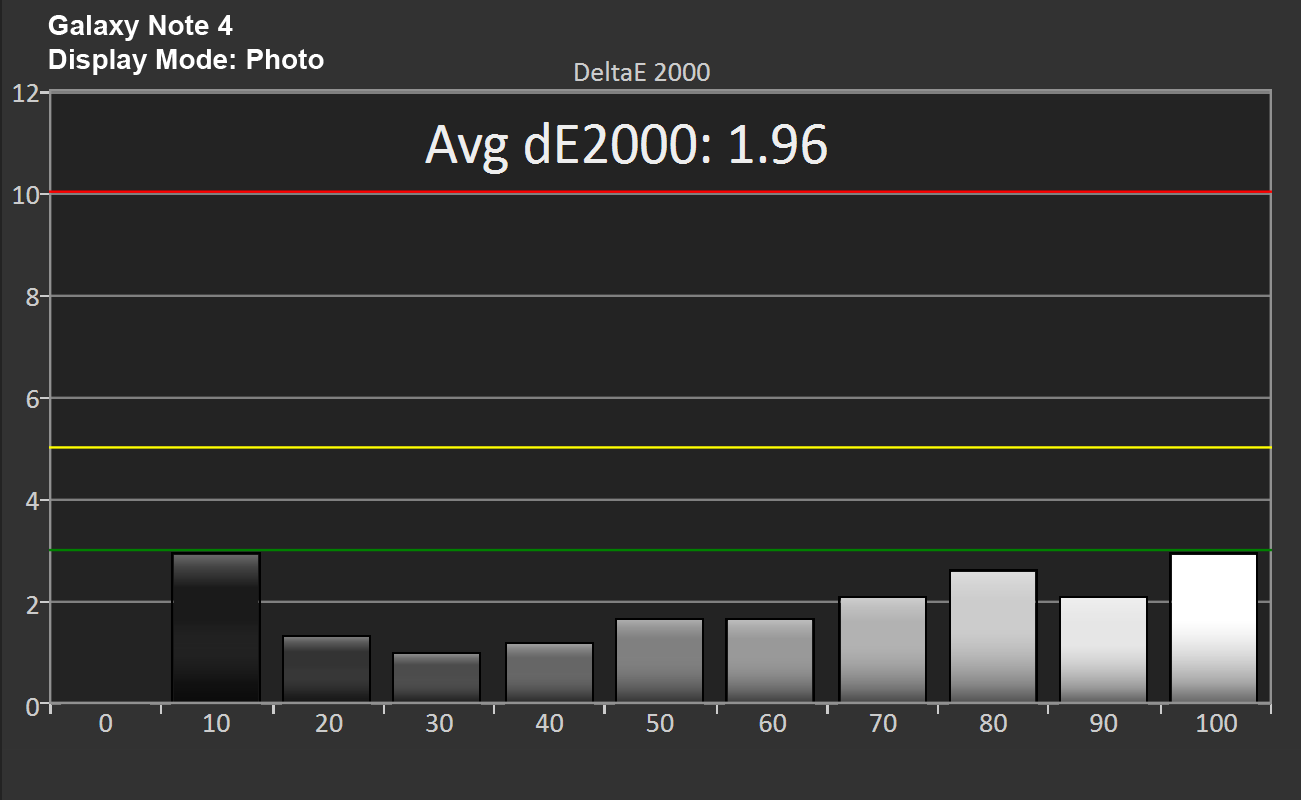
The grayscale accuracy for the Note 4 in both the Basic and Photo modes is excellent, nearly matching the exceptional accuracy of the Galaxy S6. Average ΔE2000 is below two and error at any single grayscale level remains below three. Grayscale error goes up dramatically when switching to Cinema mode, climbing steadily towards white due to the blue shift we saw in the RGB balance chart and producing visible errors similar to what we saw with the Nexus 6.
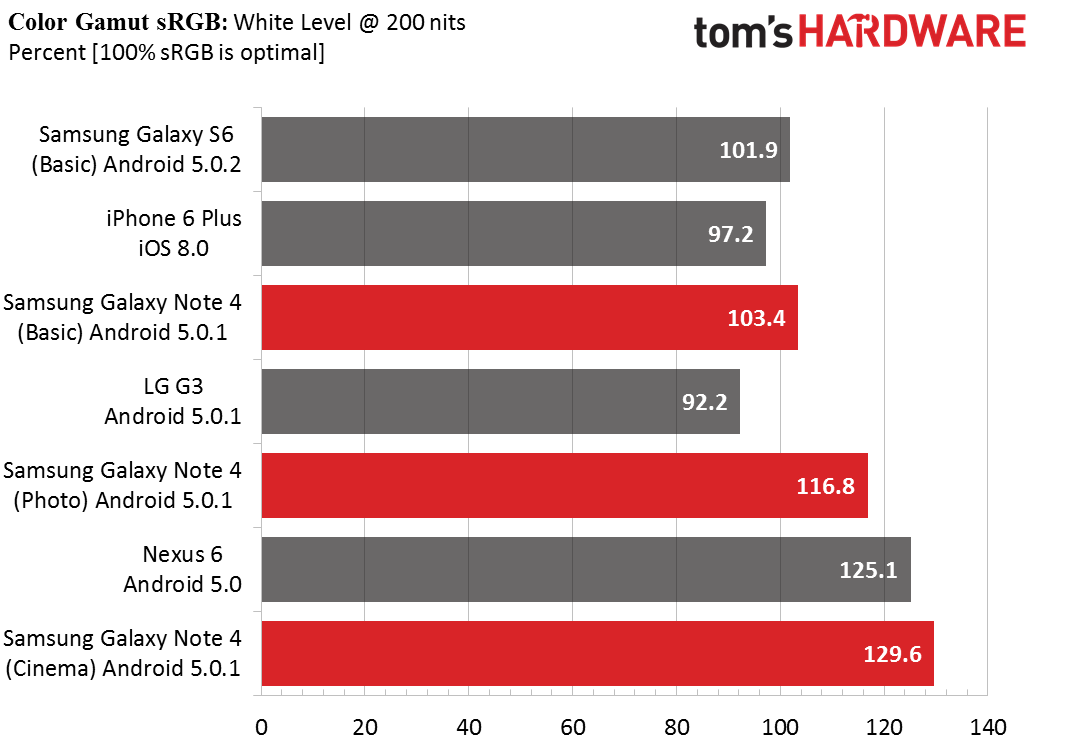
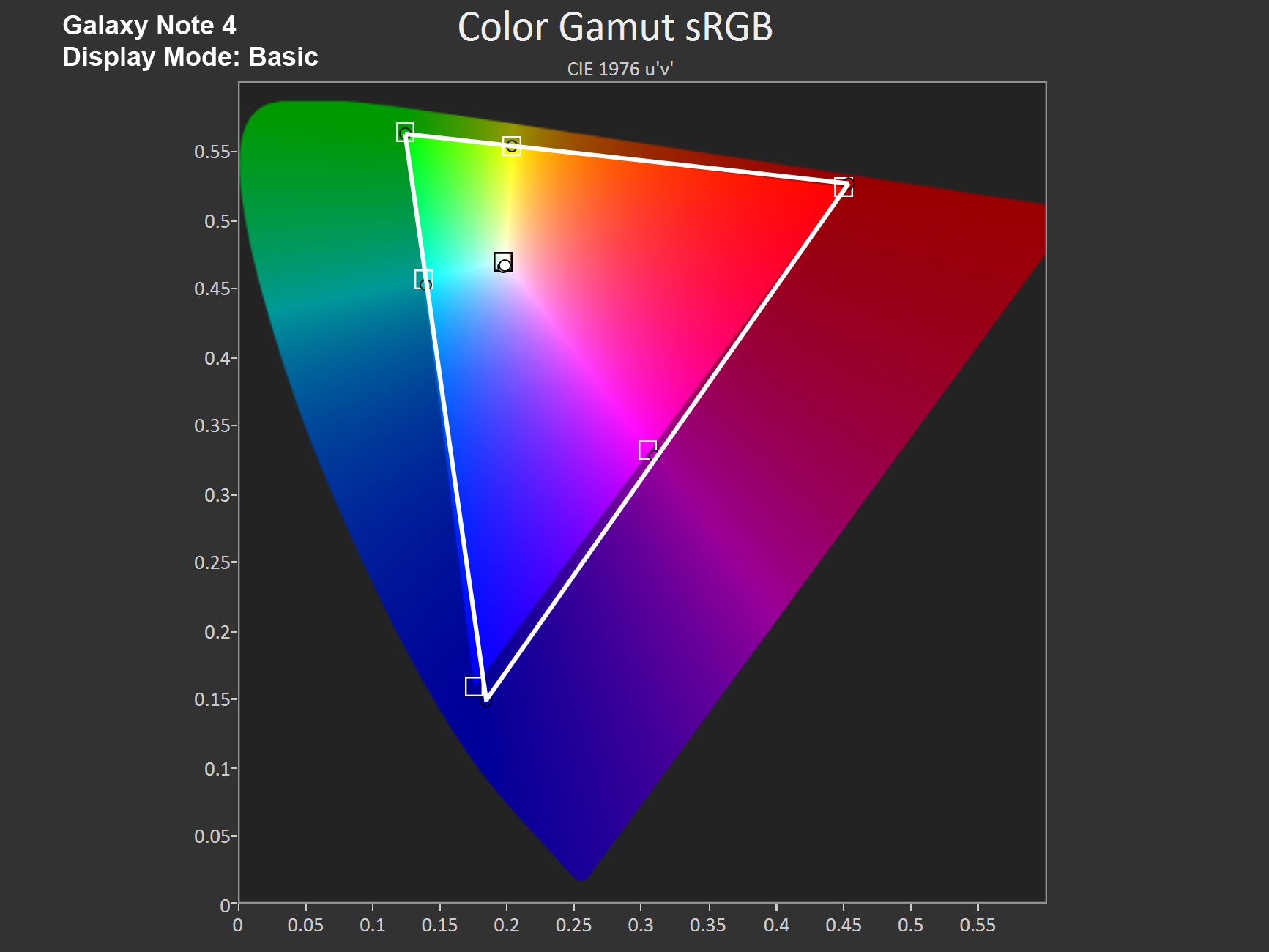
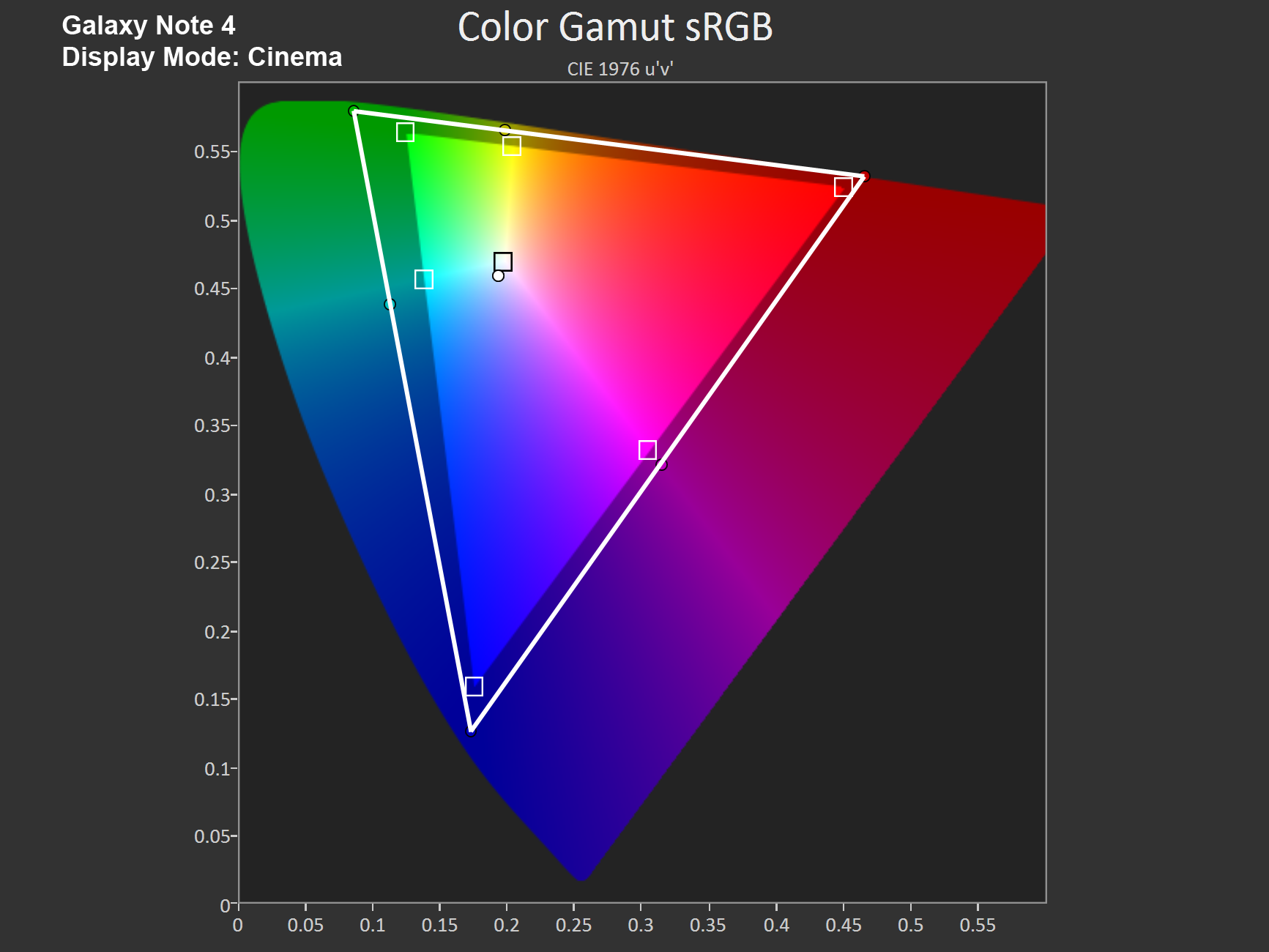
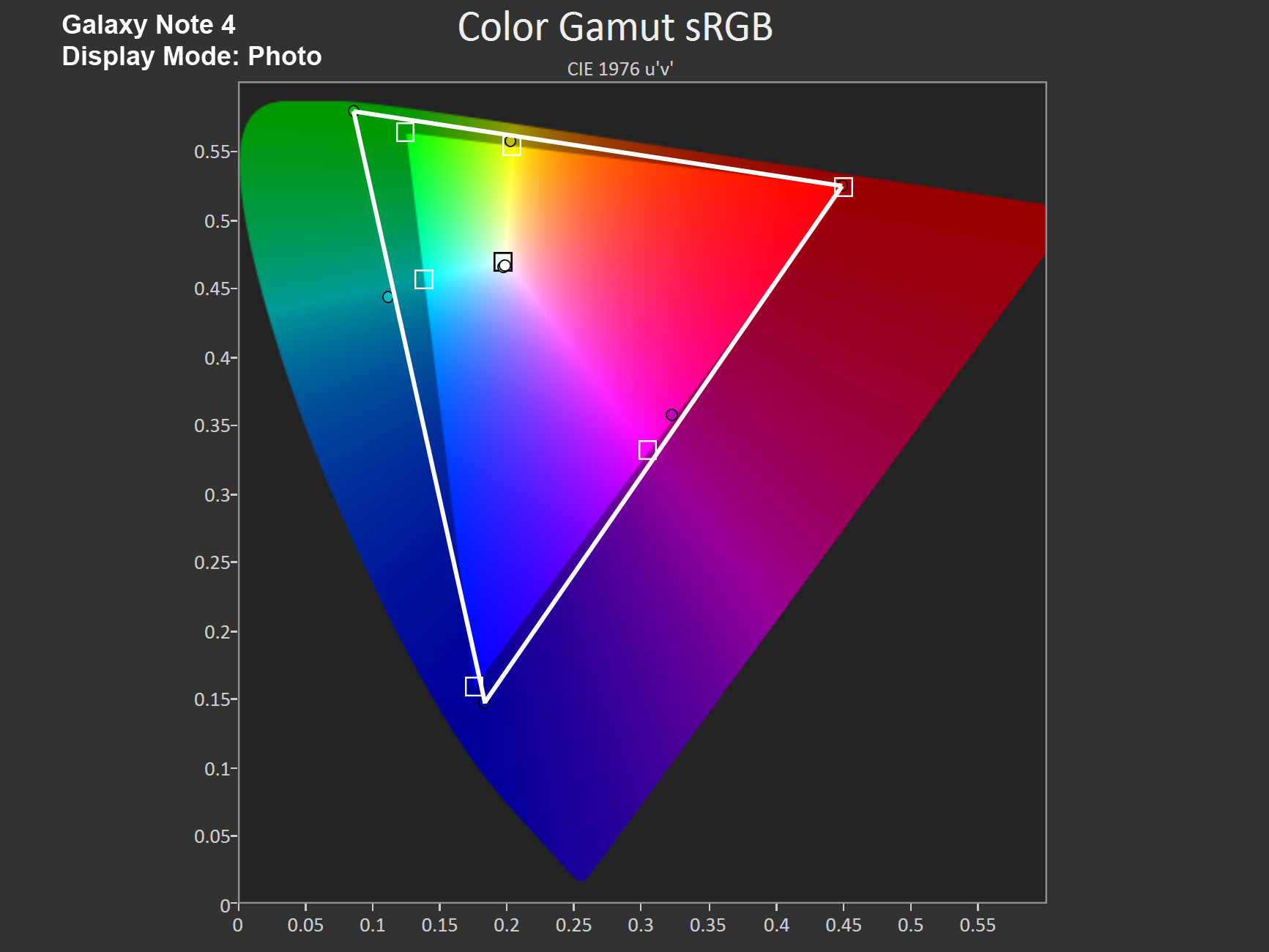
The Note 4's Basic mode does a good job of covering the sRGB color space, only missing on the blue corner of the triangle. Photo mode is similar, but extends green tones beyond sRGB. Cinema is a true wide-gamut mode covering about 130% of the sRGB color gamut. This leads to over saturated, neon-like colors that do not look natural, just like we saw with the Nexus 6.
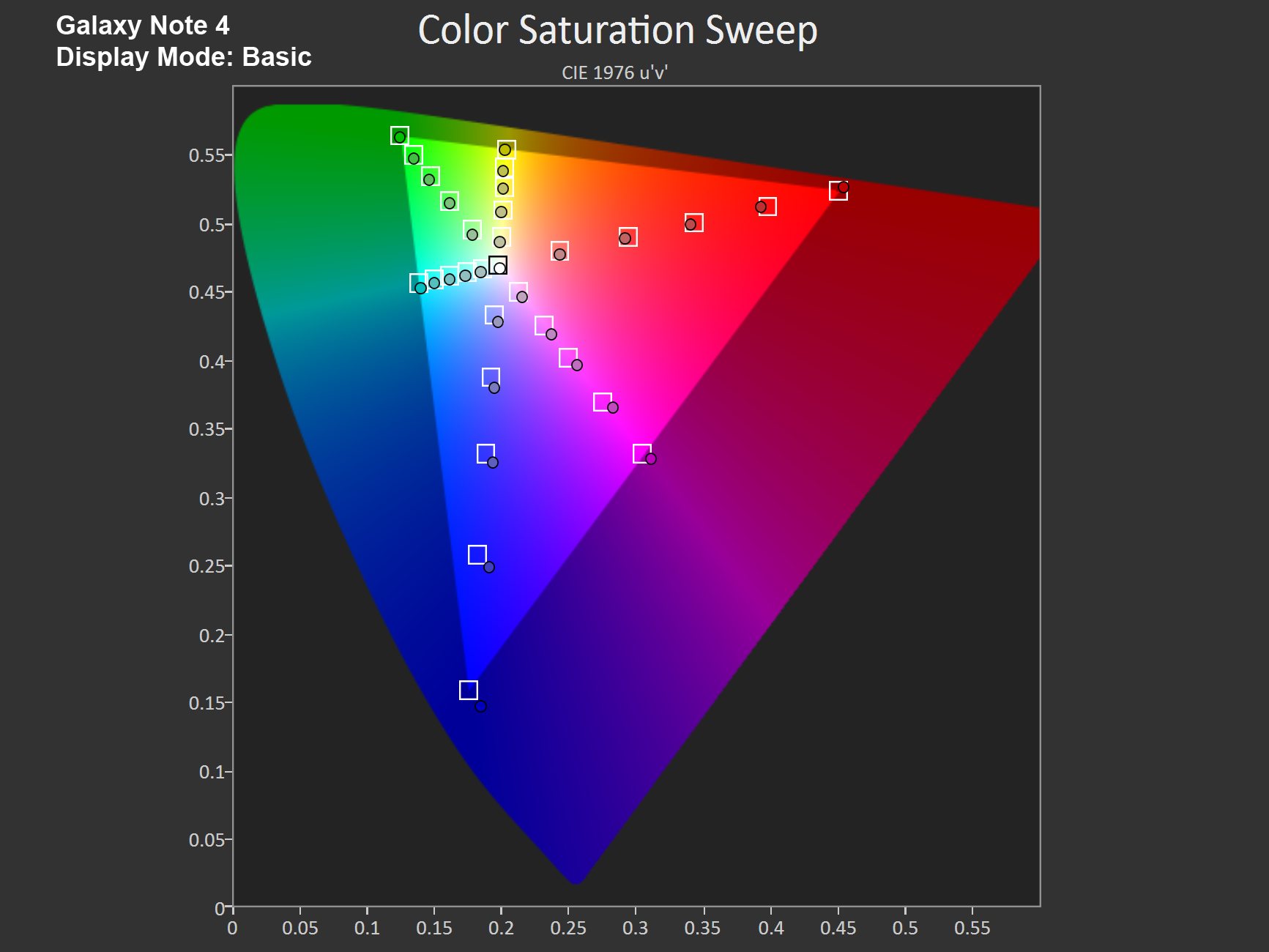
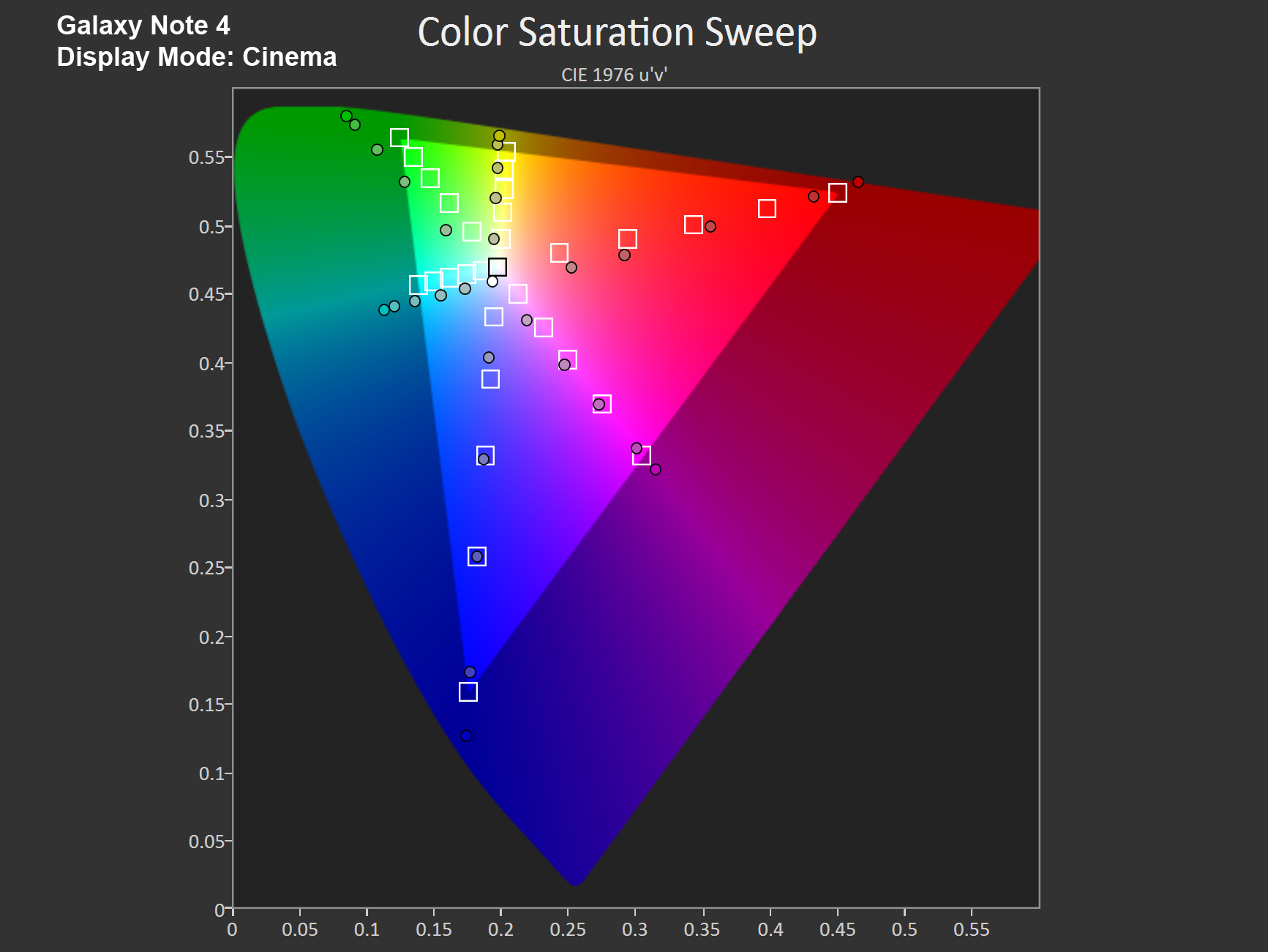
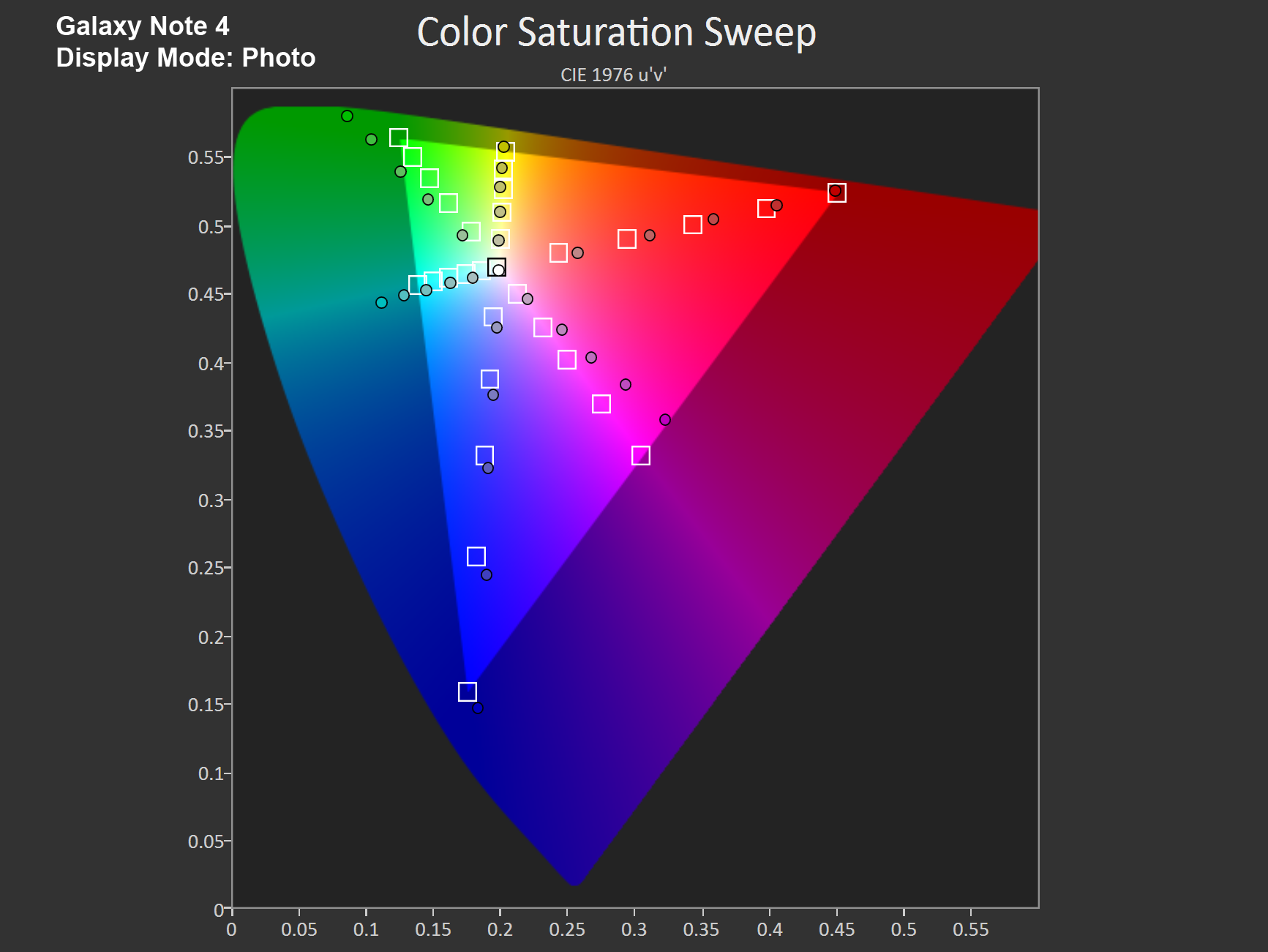
In the color saturation sweep, we see the Basic mode perform very well once again. Each saturation level hits the target and there's no hint of color compression. Photo mode shows a slight red shift in magenta tones, but still no significant color compression. This trend does not hold when activating Cinema mode, where we see significant color compression for all colors. Each box/dot pair is a 20% step in saturation, so, for example, anything above 80% saturation for green essentially looks the same.
These graphs also show the effects of using a wide-gamut screen to view sRGB content. In Cinema mode, for example, a picture showing green grass at a 60% saturation would be displayed at 100% saturation relative to the sRGB gamut, effectively making the grass look "too green" or vivid.
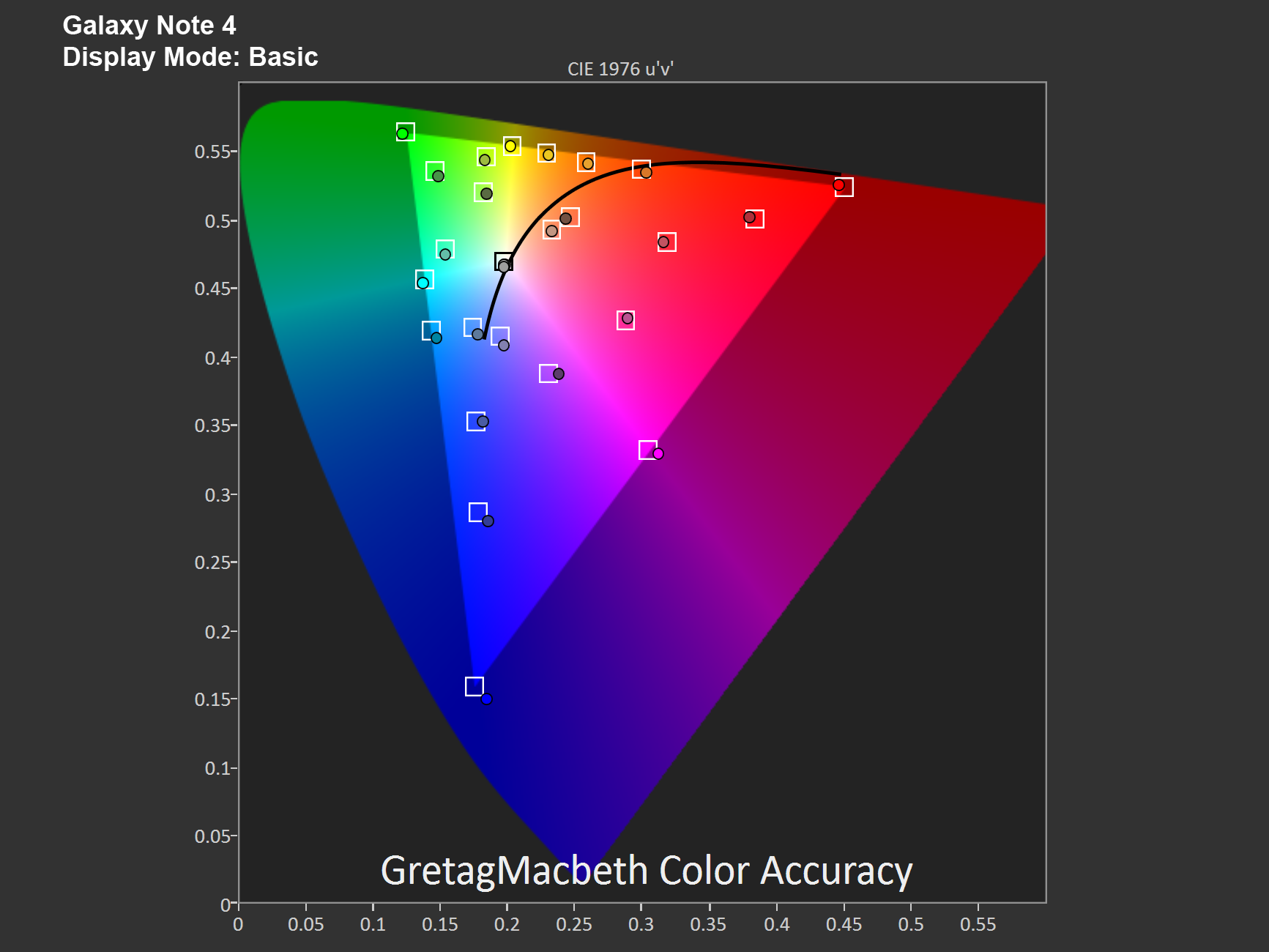


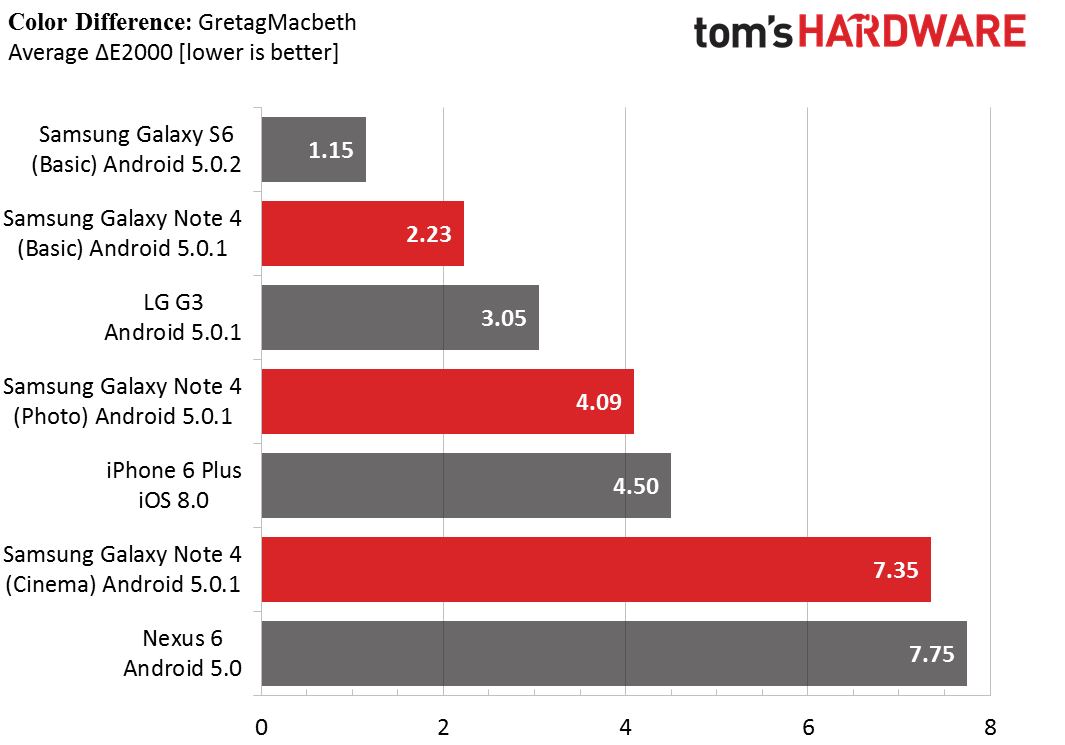
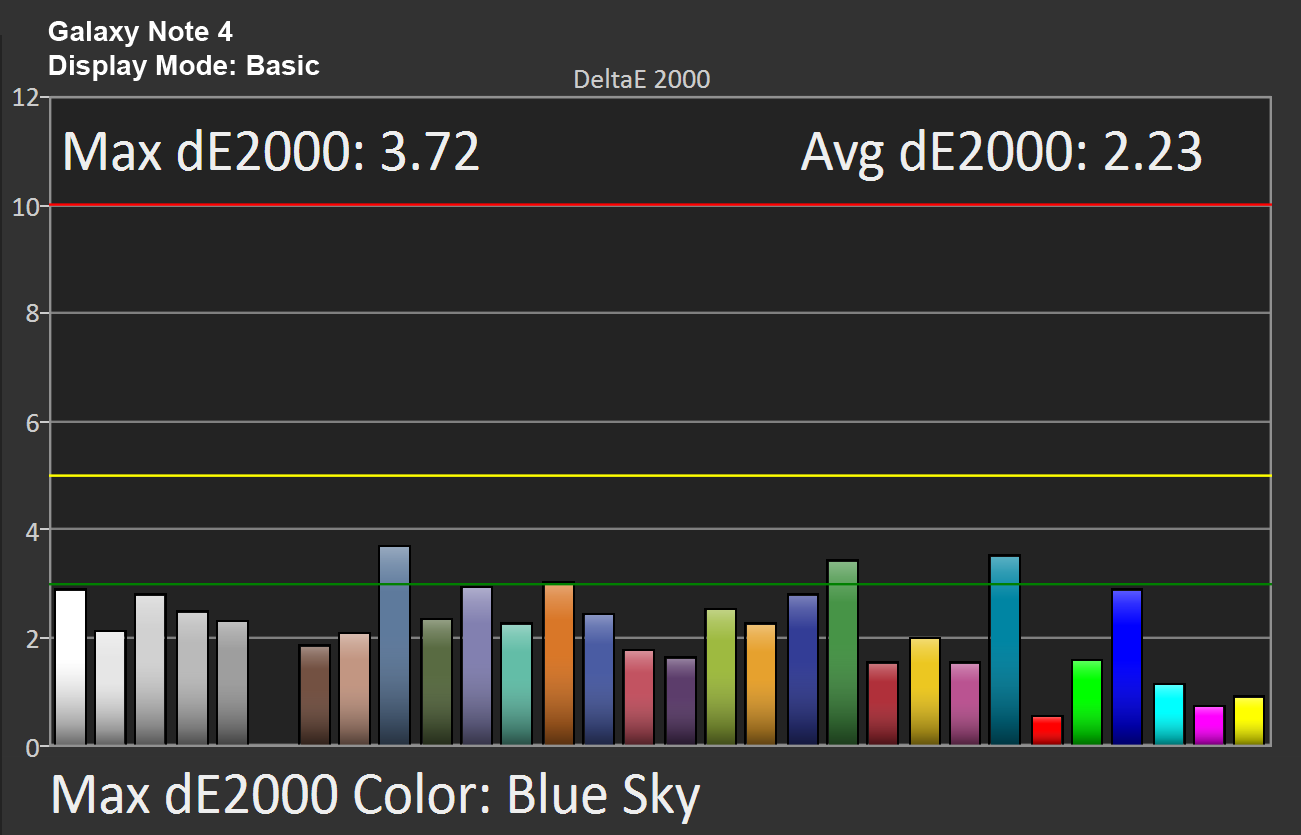
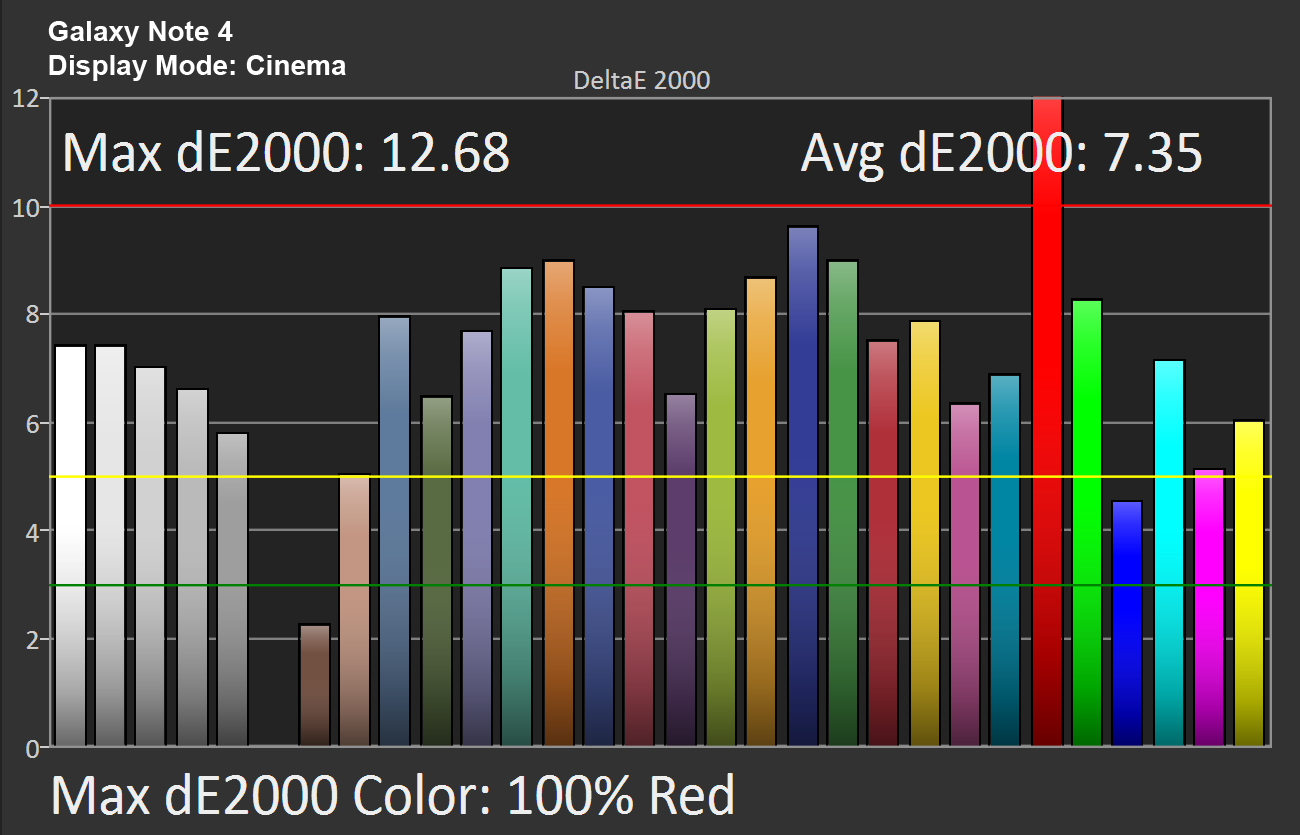
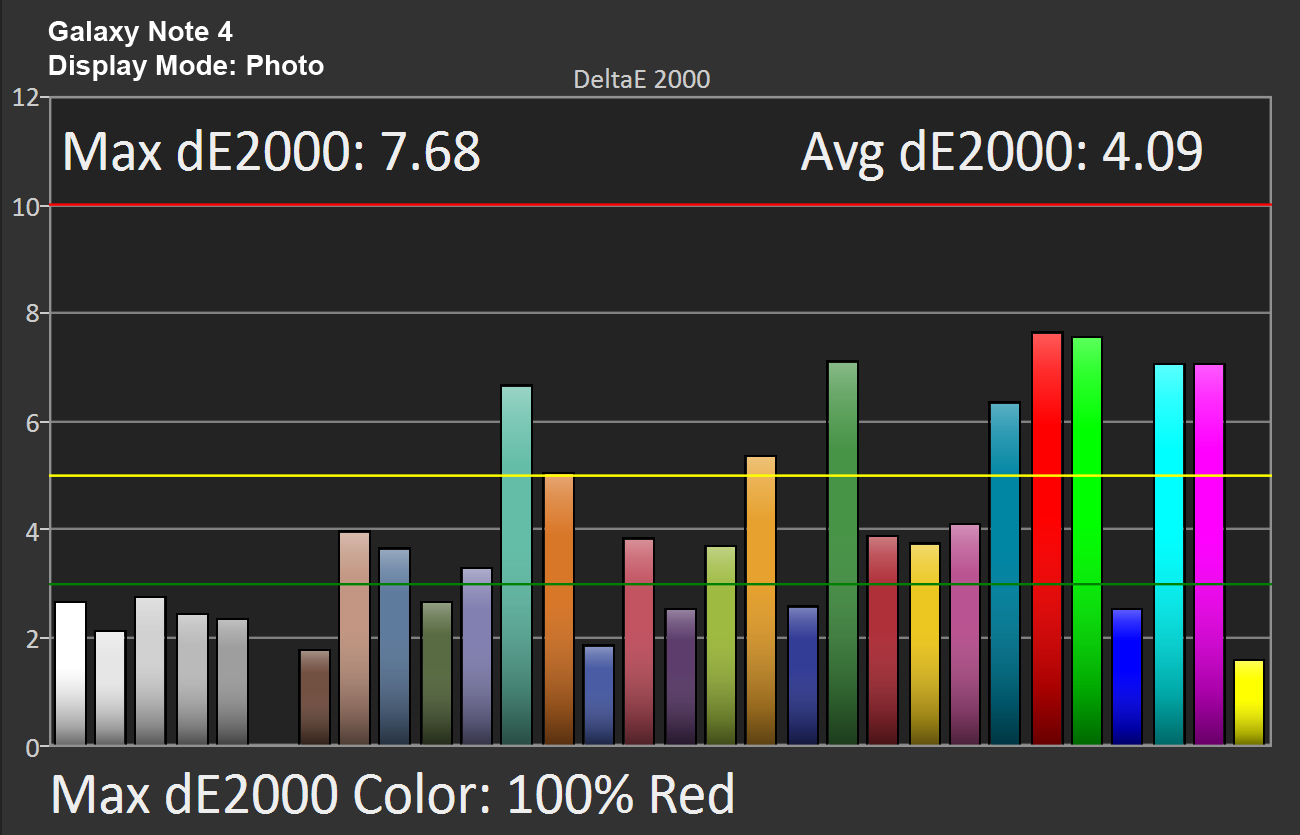
Color accuracy for the Note 4's Basic mode is very good, with nearly every tested color showing an error of less than three. Things get progressively worse for the Photo and Cinema modes, however. Cinema mode is nearly as bad as the Nexus 6; most tested colors have an error above five and a maximum error of almost 13.


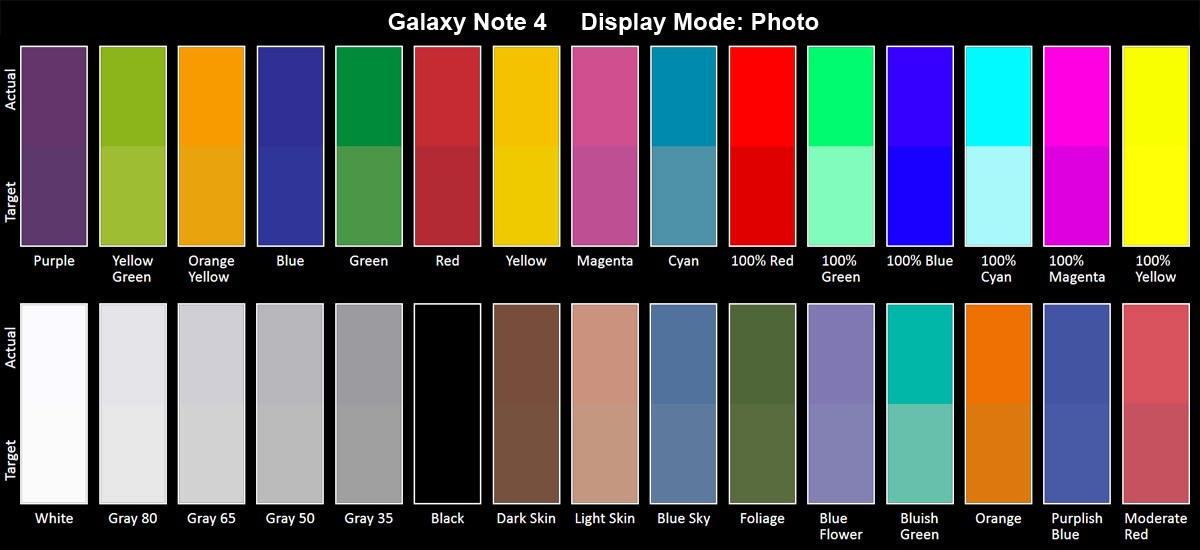
Full Size Images: [Color Palette: Basic], [Color Palette: Cinema], [Color Palette: Photo]
The color palettes above show the target color on the bottom versus the displayed color on the top and are a less abstract way of looking at color accuracy. Since our content system automatically applies additional compression to JPEG images, we've included links to the originals devoid of the heavy compression artifacts.
The display in the Galaxy Note 4 is one of the best currently on the market. Max brightness for AMOLED screens may still trail LCDs, but Samsung's auto-boost feature makes up the difference for extreme visibility cases at least.
Irregardless of your display preferences, you should find one of the Note 4's display modes to your liking. Basic mode is a well-calibrated, proper sRGB mode that delivers accurate colors and grayscale values that purists will enjoy. For those less concerned about accuracy and who like their colors brighter with more "pop," there's Cinema mode. Finally, Photo mode provides a reasonable compromise between these two extremes.
Audio Performance
Naming a product "Note" is a clear indication that its primary purpose is not for playing media, a decision exemplified by the mono external speaker. Located around back, it's mostly an afterthought. A single-channel class D amplifier from Maxim Integrated helps it get reasonably loud without succumbing to distortion, but obviously bass notes sound anemic.
Having the speaker firing in the opposite direction of your ears hurts both perceived loudness and the sound that eventually reaches you. Since your basically listening to reflected sound, the treble is attenuated and everything sounds a bit hollow. Cupping and orienting your hand behind the phone just right improves the volume and sound dramatically, but this is hardly an ideal way to hold your phone and the sound still falls short of other devices. Also, when watching a video on the Note 4 in landscape, our fingers would fall directly on top of the speaker, partially blocking the sound. A similar problem occurs when setting the phone down on a table. The raised ridge in the middle of the speaker ensures a small air gap between it and the surface it's resting on, but it still sounds muffled. This applies to voices on conference calls too. Raising the phone off the table surface by wedging a pen or something underneath helps voices sound much clearer.
It's probably best to just leave the external speaker for ringer duties and use some nice headphones for everything else. Thanks to Qualcomm's WCD9330 audio codec, headphone output is excellent. Based on our subjective listening tests, the Note 4 rivals the Sony Z3 (which uses the previous generation WCD9320 codec) and iPhone 6 in quality. Also, twisting the plug while seated in the headphone jack did not produce any static like it does on the iPad Air 2.
Current page: Display And Audio Performance
Prev Page Hardware Design Next Page Camera: Hardware And Software-
ZolaIII All in all nice review but I somehow feel you skipped a litle audio section. Not that I blame you much for it as Qualcomms solution is nothing special & it's far behind WolfsonMicro's WM5110 used on Exunos equipped models. Looks like you still didn't got to the bottom of bus frequency scaling dependencies on this Qualcomms SoC gen. ??Reply -
Vorador2 Replythis came out long ago!
It's a tradition. Everybody reviews phones in the week before or after a phone is released.
Tomshardware is better than that. Fashionably late to the party. -
jafrugh Replythis came out long ago!
It's a tradition. Everybody reviews phones in the week before or after a phone is released.
Tomshardware is better than that. Fashionably late to the party.
Well if you think Toms's Hardware needs to be quicker on the draw for phone reviews, go to this article: http://www.tomshardware.com/news/mobile-editors-wanted,29105.html -
Vlad Rose Replythis came out long ago!
I thought the same thing considering I'm using a Note 4 Edge right now... lol -
alex davies Replythis came out long ago!
The difference between our review and others is that we tested the Note 4 running the Lollipop update, which only came out recently.
We also compare its performance to newer devices such the Galaxy S 6, so you can see how the Note 4's older SoC compares to the latest and greatest. -
MobileEditor ReplyAll in all nice review but I somehow feel you skipped a litle audio section. Not that I blame you much for it as Qualcomms solution is nothing special & it's far behind WolfsonMicro's WM5110 used on Exunos equipped models. Looks like you still didn't got to the bottom of bus frequency scaling dependencies on this Qualcomms SoC gen. ??
I agree with you regarding our audio testing. I'm definitely not happy with it. We need to acquire some testing equipment, but the hardware we found cost $30k!!! Needless to say, we're still using my ears, because they're cheap.
If you, or any of our readers, could point me towards some audio testing equipment that mere mortals can afford, please PM me.
I did not investigate the bus scaling on the Note 4, partly because this review was finished by then and partly because the Note 4 did not exhibit "unusual" behavior. We will be examining this for the GS6.
- Matt H. -
10tacle Nice review and very useful to people like me needing an upgrade after skipping two generations of smart phones. I usually keep mine 3 years, and my Droid Bionic is like running a Core 2 Duo desktop these days. I'm still debating between the Note or Galaxy. Apples are out because 1) I don't like the fact that the battery *cannot* be removed to completely shut the phone off, and 2) no MicroSD slot for memory expansion.Reply
There will come a time when all smart phones from all manufacturers no longer allow SD memory upgrades, and I think that time is coming sooner rather than later. After all, one can go buy a 128GB $100 MicroSD card, but if Apple users want a 128GB phone, they have to shell out another $200 clams from the base 16GB model, and they don't get the extra "free" GB memory to start with after upgrading that came with the Android.
But with that said, there are some people reporting about overheating and battery drain with their Note 4. Battery drain can be a problem with the provider though like a cell tower being down. Plus, the Note 5 is coming in a few months, possibly in July. I'm hoping it still has an SD slot otherwise I'll get the 4 and hope the serious overheating and battery drain reports are a fluke.
